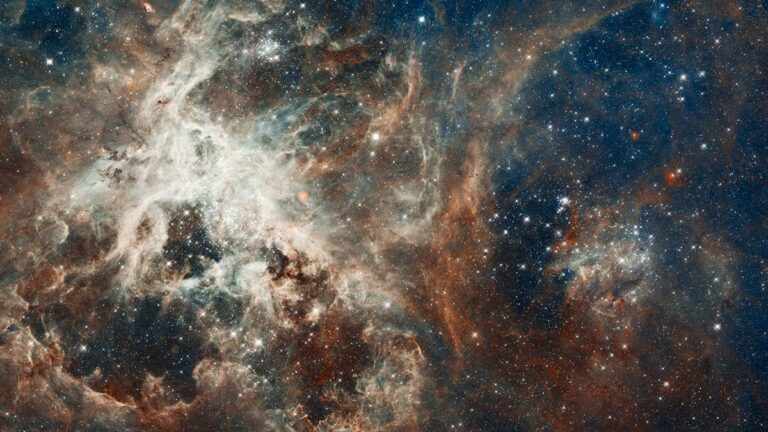The Tiniest Galaxies in Our Universe Host the Most Prodigious Star Factories. Here’s the Explanation.
There is a potential insufficiency in the number of stars within them undergoing supernova explosions.
Some of the most substantial and intense regions where stars form are discovered within the smallest galaxies. Scientists posit that this phenomenon arises because, in the so-called dwarf galaxies, stars that reach the end of their lifecycle are more inclined to transform into black holes rather than undergo supernova explosions. This distinction is significant enough to result in a 10-million-year delay in dwarf galaxies expelling their star-forming material, a process typically triggered by the forces of supernovas.
Essentially, dwarf galaxies can retain their valuable reservoir of star-forming molecular gas for an extended period. This extended retention allows the growth of star-forming regions in both size and intensity, leading to the generation of more stars.
Examples of such expansive star-forming regions in local dwarf galaxies include 30 Doradus (the Tarantula Nebula) in the Large Magellanic Cloud, situated approximately 160,000 light-years away, and Markarian 71 in the galaxy NGC 2366, positioned about 10 million light-years away.
Star-forming regions have the capacity to produce stars of varying masses, predominantly yielding smaller stars but also creating a few massive stars. When these massive stars conclude their life cycle after a few million years, their cores collapse to form either a neutron star or a stellar-mass black hole. In the former scenario, the outer layers of the star rebound off the neutron star, leading to a supernova explosion. Conversely, in the latter case, almost the entire star collapses into the resulting black hole without a substantial explosion.
“As stars go supernova, they pollute their environment by producing and releasing metals,” stated Michelle Jecmen, an undergraduate researcher at the University of Michigan and the study’s lead author. The universe initially produced only hydrogen, helium, and a trace of lithium during the Big Bang. Subsequent elements, referred to as “metals” by astronomers, were forged within stars or their explosive events. These metals, dispersed across the interstellar medium, play a role in new star-forming regions and become integrated into the next generation of stars. The presence of specific metals within a star can influence its evolution, with high-metallicity stars more likely to produce a neutron star and a potent supernova.
Crucially, the successive supernova explosions generate a “wind” capable of expelling any remaining molecular gas—crucial for star formation. Larger, more evolved galaxies like the Milky Way have accumulated a higher abundance of metals over time due to their extensive star-forming history. In contrast, smaller dwarf galaxies, historically featuring less star formation, possess more primitive compositions with fewer metals. However, when a star-forming region in a dwarf galaxy initiates, the lower metallicities of its stars make them more prone to forming black holes rather than undergoing powerful supernova explosions. Consequently, it takes a longer time for the region to become enriched with metals and commence producing stars that generate supernovas with potent winds that expel all gas.
“We argue that at low metallicity … there is a 10-million-year delay in the start of strong super-winds, which in turn results in higher star-formation,” explained Jecmen.
Jecmen’s supervisor and co-author of the study, Michigan astronomer Sally Oey, commented, “Michelle’s finding offers a very nice explanation. These galaxies have trouble stopping their star formation because they didn’t blow away their gas.”

Oey, leading observations with the Hubble Space Telescope, has uncovered supporting evidence for Jecmen’s model. The team reported these findings in the Nov. 21 issue of The Astrophysical Journal Letters, focusing on Markarian 71. In particular, Oey sought triply ionized carbon, where atoms lose three electrons due to high-energy photons. The Hubble observations revealed a notable presence of triply ionized carbon at the center of Markarian 71, a phenomenon occurring during the cooling of gas and the interaction of radiative outflows, which extract energy from the gas, with warmer gas. Notably, the absence of hot super-wind, characteristic of multiple supernova explosions, in Markarian 71 challenges the existence of expected cooling outflows.
These findings also shed light on the conditions for star formation in the earliest galaxies of the early universe, known as “Cosmic Dawn,” just a few hundred million years post-Big Bang. These early galaxies, although small, exhibited intense star formation and low metallicity. When observed, they often display characteristics such as gas clouds clustering together, with ultraviolet light penetrating the gaps between the clumps, resembling the “picket fence” model. This model draws an analogy to sunlight filtering through gaps in a garden fence.
The proposed 10-million-year delay in the emergence of supernova winds provides an explanation for the development of large gas clumps in early galaxies. Michelle Jecmen remarked, “Looking at low-metallicity dwarf galaxies with lots of ultraviolet radiation is somewhat similar to looking all the way back to the cosmic dawn.”
It’s intriguing to note that insights into the earliest galaxies can be gleaned not only through sophisticated, high-cost space telescopes but also by studying our smaller celestial neighbors.
A paper describing these findings was published on Nov. 21 in The Astrophysical Journal
Do not forget to share your opinion with us to provide you with the best posts !




0 Comments